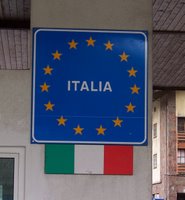
TO ALL
“All roads lead to Rome” is probably not axiomatic for the 21st century, but I can now verify first-hand, that at least SOME roads do still lead to Rome. Travel time by car from Heidelberg is 16 hours. The manifest for this particular expedition was as follows: my dad and brother (Curt), Alan, Amy, and a friend from Heidelberg named Marion. Mike flew to Rome and met us there so that he could limit his time away from work to a 4 day pass and not burn up leave. The rest of us elected to drive to Rome.

Roads
Leading to Rome
Although Ryanair is cheap and gas is expensive, with 6 people traveling together, driving is still somewhat cheaper than flying.
Also, driving allowed us to (1) bring some food with us which would have been impossible with Ryanair’s stingy baggage allowance and (2) to explore a couple of other destinations enroute to
Rome. Amy did most of the driving on this trip and she did a spectacular job.
Our first destination was Firenza, Italy -- otherwise known as Florence! (Alan and I are in the midst of an ongoing discussion about how these European cities have come to be known by a different name than the one used by their inhabitants. So far we haven’t come to any definitive conclusions.) Our base camp for exploring Firenza was Camp Darby, an American military base which is about an hour away – near Pisa. We stayed two nights at Camp Darby which gave us a full day in Florence to take in --
(1) the Uffizi Gallery (pronounced oo-FEETS-ee), home of lots of famous Renaissance paintings,
(2) the Academia Galleria, home of the original statue of David by Michaelangelo as well as some other sculptures, and --
(3) the Duomo, the Cathedral in Florence.
On the way back to Camp Darby at the end of the day we made a quick stop at the Leaning Tower of Pisa and Amy had fun taking pictures of us holding up the Leaning Tower while Alan took pictures of the people taking pictures of people holding up the Leaning Tower.
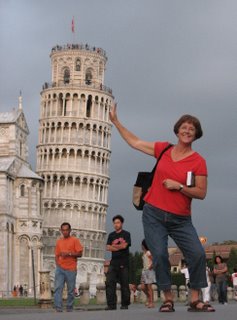
None of us in the group claim to be art connoisseurs but it seemed irresponsible to be in
Europe and especially to go to
Florence without taking in at least some of that sort of thing and attempting to broaden our horizons at least a little.
I’m not sure that the Uffizi Gallery was all that enlightening or enjoyable but seeing the original full-size David in real life (not just a picture in a book) was impressive. (For all you non-art connoisseurs this is the Biblical -- although totally naked -- David with a slingshot over his left shoulder and a stone in his right hand.)

We learned on this trip when Italian museum say “no pictures” they mean NO PICTURES – not even without a flash. This is one place where my basic sin nature rears its ugly head and I become recalcitrant. With a digital camera it’s pretty easy to take pictures unobtrusively and I have a history of doing that occasionally. In this case, I really wanted a picture of “David” – not just a postcard, but a picture to add to my computer screen-saver collection. My first attempt was a disaster. I thought for a few moments I was going to be asked to leave. I stood between a huge pillar and the wall where I thought no one would notice me and pulled out my camera. A museum employee pounced on me immediately and told me in no uncertain terms “no pictures, put camera in bag.” Unfortunately rebuke tends to egg me on. I bided my time, found a “better” location and eventually got a fairly decent picture. The only rationale I can think for not allowing pictures without a flash is that it ruins postcard sales. My response to that is – “If they didn’t have to hire so many guards to enforce the ‘no pictures rule,’ they would save as much in expenses as they lost in postcard sales and have happier customers to boot.” Many of the other museums in Europe allow pictures without a flash. I suspect that this is an illustration of the “almost third world” way in which Italians tend to do things – decisions aren’t always based on facts nor are they always terribly logical.
The Duomo in Florence is worth a comment or two. It is the first cathedral I’ve been in where there were no chairs or pews. It is just a big empty shell. That would seem to imply that it is no longer being used as a place of worship. But. . . . they make a big deal of making everyone cover up their shoulders and thighs as they enter the building on the pretense that it is a “sacred place.” So . . . do they move in pews or chairs when they have services or is this another example of Italians not always being very clear thinking or consistent? On another note – you would think at this point, having seen as many cathedrals as I have, that they would all begin to look alike. And, to be honest, I don’t know that I could correctly identify ANY of the cathedral’s I’ve seen based on a picture of the inside, but I COULD identify many of them based on a picture of the outside. The Duomo in Florence is one of those that cannot be easily confused with any other cathedral. Rick Steves calls it “the cathedral in pajamas.” “The cathedral in boxer shorts” might be even better.
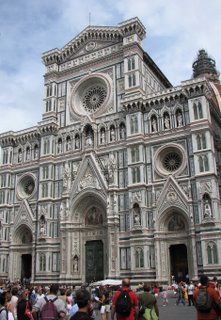
The Duomo in Florence
Our next stop after
Florence was the
Amalfi Coast which is actually south of
Rome.
"To drive or not to drive
That is the question
Whether ‘tis nobler in the mind
To endure the pangs of public transit
Or to take arms against the sea of constraints
And by opposing . . . get better pictures?"
I left this decision mostly up to Amy, knowing that if we drove, she would have to be the driver -- I would not be able to refrain from looking at the scenery well enough to maintain the van in its original shape. As it turns out I managed to inflict (indirectly) damage to the van without even being in the driver’s seat. But I’m getting ahead of my story. The advantages of driving were (1) the ability to stop at pull outs to take pictures and (2) greater flexibility in terms of exploring towns along the way and stopping to eat lunch. The disadvantages were (1) the sanity of the driver could be seriously jeopardized, (2) the ability of the driver to enjoy the scenery would be severely limited, and (3) the possibility of taking a boat back to the starting point and being able to enjoy the scenery from another prospective would be eliminated.

Scene from
Amalfi Coast Road
As it turned out the deciding factor was none of the above – it was a bit of trivia that Alan brought up at the 11th hour. He talked Amy into driving so that he could use the GPS that goes with my PDA (and runs ONLY off of DC power from a cigarette lighter) to write down the coordinates for every picture I took along the way so later on he could “geo-tag” them using a feature of “Google Earth."
At this point a couple of notes about driving in Italy. (1) I first learned about the Amalfi Coast from my hair stylist in Tacoma whose name is Edward. According to Edward one of the axioms of driving in Italy is that “the faster you go, the skinnier you are.” He actually had the gall to state this supposed axiom in Mike’s hearing -- it was the only time Mike has ever been with me when I got a haircut – and it may be the last time that Edward cuts my hair!!!!. Mike didn’t actually get to do any driving in Italy, but it seems that he has been testing the validity of this idea in Heidelberg and the result is that both of our cars now have missing or damaged side mirrors. (2) Italians seem to have a propensity for driving with two wheels just over the lane line – either in the lane to the right of them or in the one to the left of them. We observed this strange behavior both on the autostrada (i.e. the freeway) and in congested parts of town. Maybe they are trying to see ahead???? Who knows. (3) In Germany if you look in your rear view mirror to change lanes and notice someone in the lane next to you flashing their headlights at you it means “I’ll let you in.” In Italy it means “Get out of the way, I’m coming through.” It pays to know what country you are in!
Which leads me to a comment about Italians in general. As Alan put it, their society seems to be based on aggression, i.e aggressiveness is a character quality that they value highly. Hence we witnessed an inordinate number of fights – either physical or verbal – in the time we were in Italy. Maybe this is also why they are so obsessive with “no pictures” rules??? And why they tolerate aggressive begging on the streets??? And why they drive with two wheels in the next lane??? Contrast this mindset with the Swiss who value politeness and consideration – to the extent that some would consider it improper to take a shower after 9:00PM at night because you might disturb your stairwell neighbors!
So . . . back to the Amalfi Coast. After spending the night in a delightful pension in a little town on the coast called Sorrento, we took off the next morning to “do” the Amalfi Coast. It truly was spectacular – sheer cliffs, expansive views, villages clinging to the steep slopes above the cliffs, brilliant blue water, beaches way down below the road accessible only by stairs (or sometimes an elevator!), Mt. Vesuvius in the distance etc, etc. We had a beautiful, sunny, clear, day for exploring. The road was not quite as hair-raising as all the tour books implied and there were actually some pull outs where we could park and take pictures and allow Amy to enjoy the views, too. All that doesn’t necessarily mean that we recommend driving the Amalfi Coast but just that it IS “doable.”

Stairway
leading to a beach
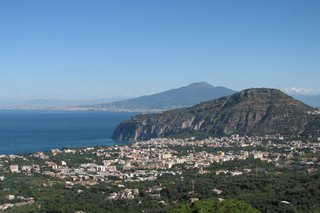
Mt. Vesuvius as seen from
Amalfi Coast Road
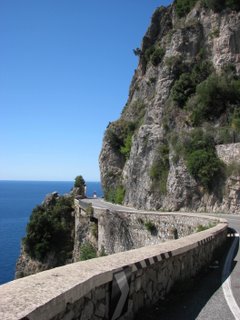
Scene from
Amalfi Coast Road

Scene from
Almalfi Coast Road
We did have one mishap – could be minor or major depending on one’s view of such things. I was riding in the middle seat of the van on the side next to the ocean. We were going really slowly through some little town and stopping occasionally for traffic. I asked permission from the group to leave the sliding van door open while we drove so that I could see better and take pictures. We had a little discussion about whether the door being open would cause the van to be “wider” and thus make it harder for Amy to avoid scraping against something and we decided that the open door didn’t stick out any farther than the R.H. rear view mirror. I got approval from a couple of people and only mild disapproval from others, so I opened my door. (You can see again what a compliant person I am!) Note: had Mike been with us at this point, he would NOT have allowed this to happen! The arrangement worked quite well for a while and I got some really good pictures. As we laughed and giggled our way through town, acting like a bunch of teenagers, we heard an Italian on the sidewalk call out “Americano!” Was the open door the give away or the “USA” in tiny letters on our license plate? When we left the little town and Amy starting picking up a little speed, she started insisting that I close the door. Unfortunately I was too slow in complying. I asked her to pull over at a little “viewpoint” I saw coming up, intending to close the door there. As she turned right into the pull out, she cut the corner too close and scraped the sliding door against a concrete barrier. Our little party came to an abrupt end and the euphoria of the day never quite returned. Fortunately the sliding door still opens and closes – although it’s a little stiffer and a little noisier than before and the electric lock doesn’t work. The paint and metal damage is not exactly a “minor,” but it could be worse. What we don’t know yet is whether it might leak in a good downpour.
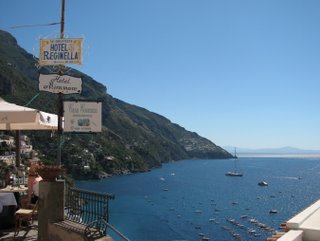
Scene from
Almalfi Coast Road
So . . . . one sentence about the scenery along the Amalfi Coast and a whole long paragraph about our mishap doesn’t seem quite right, but I don’t know what else to say about the scenery. Words just don’t do it justice. Maybe a few pictures will help.

Scene from
Almalfi Coast Road

Scene from
Almalfi Coast Road
We ended our day on the
Amalfi Coast at a campground on the northern edge of
Rome called Camping Tiber (“
Tiber” as in the
Tiber River, pronounced
TEE-burr), where we had reservations for a couple of trailers for the next five nights.
At this point we parked our car and didn’t move it again until time to head home.
Driving IN Rome was not an option we had ever considered.
Camping Tiber was the cheapest thing I could find with AC. I understood from the tour books that many accommodations in Rome do not have AC and Rome can be sweltering in August. Camping Tiber was a ways out from the center of Rome but close to a metro line plus the campground provided a free shuttle to the nearest metro stop. Air conditioning in Italy is typically operated with a remote control – like a TV remote. If you pay for AC, they give you the remote control, if you don’t pay for it they don’t. As it turned out, the days in Rome were pretty hot, but the nights were cool – almost desertlike. The first night we were there we turned off the AC in our trailers before we went to bed and opened all the windows. We woke up freezing the next morning. The next night we turned in the AC controls to save a little money, closed all the windows before we went to bed, and still weren’t any too warm. Amazing.
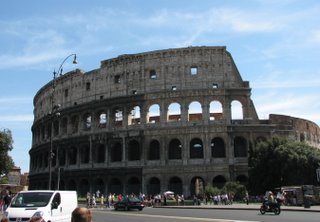
The Colosseum
Rome is rightly called “the junkyard of western civilization” and there is truly a lot there to see. However, as with most sightseeing trips, sometimes the little things that happen along the way, that have little if anything to do with the sights themselves, end up being what stands out in one’s mind when it’s all said and done.

Trajan's Forum
So – before I talk about the actual sights I have a couple of stories to get off my mind – some are funny, some not.
(1) The second day we were in Rome my dad got his wallet “picked” from his pocket. It was a classic “Rick Steve’s scenario” and very preventable had we taken Rick’s advice. At our suggestion, my dad did have his wallet in his front pocket instead of his back pocket. But it shouldn’t have been in a pocket at all. One morning, we got on a VERY crowded subway. A lady and a little girl tried to wedge themselves between Curt and me as we boarded. I was concerned about the doors closing between us and getting separated so I was pretty aggressive about not letting them get between us. It should have occurred to me that the lady wasn’t just being rude -- she had targeted Dad. When the lady and little girl got in, they shoved their way to the center of the car near Dad. I was annoyed (but still not savvy) and said in a loud voice “Just shove your way in lady.” Then I noticed a passport on the floor of the car and said “Isn’t that Curt’s passport?” (It had been through the wash a couple of nights before and therefore had a very distinctive look!). I know now that, as Curt and Dad and I were distracted and struggling to retrieve the passport, the little girl (being just the right height to see into pockets) pulled Dad’s wallet out of his pocket. Moments later the metro stopped, the lady and the little girl shoved their way to the door and got out. As they were leaving somehow a man standing next to us apparently sensed that something was wrong with their behavior and said to me “Do you have anything in your pockets?” Sure enough Dad did NOT. At the moment of discovery the Metro had not yet started moving, but the doors had closed putting the lady and her little girl just out of reach . . . Argh!!!! We got off at the main train station (Termini), asked directions to a police station, filed a police report, called VISA and Discover to report the stolen cards and were back on our original agenda within a couple of hours. Fortunately, Dad only had 10 euros in his wallet and we have since verified that there are no unauthorized charges on either card, so the financial loss is negligible. Unfortunately, he had a lot of other stuff in his wallet that will be a big headache to replace – driver’s license, Medicaid card, etc, etc. So . . . . we live and learn.
(2) Our Rick Steve’s book outlines something called a “Night Walk Across Rome” that some of us decided we wanted to do. The day of the pick-pocketing Dad and Curt pooped out early and went back to the campground. The other five of us started out on Rick’s walk about 7:00PM not realizing that the metro stopped running at 11:00 PM. When we sat down to eat supper about 9:30 PM we stumbled onto that bit of information. We should have gotten right up and headed home, but we had our hearts set on supper and couldn’t pull ourselves away. Amazingly we did manage to arrive at Termini a few minutes before 11:00 PM, but . . . . they were closed. We realized that the only option for getting back to our campground was a taxi and began negotiating a price. This time we followed Rick Steve’s advice to the “tee.” We insisted on agreeing to a price before we got in the vehicle and refused to get in anything that wasn’t an official taxi – one with a sign on the top and a number on the door. We ended up negotiating with 4 different drivers before making a deal. The first one wanted 70 euros. While I was protesting to Mike that we needed to ask around some more, Alan found a kid who said he would do it for 50 euros. As we piled into his “official taxi” I clarified “50 euros?” and he said “60” . . . . and we said “50” and he said “60” and we said “50” and finally he agreed and we started out. Next thing we knew we were pulling back up to the same taxi stand again and he was saying “Can’t do it for 50.” So we got out. Another kid said he would do it for 50 euros. While the other drivers were trying to convince him (in Italian) that he shouldn’t do it for that price, an old man walked up and said he’d take us for 50 euros. We followed him to his “taxi” and got in, but then Alan pointed out that his “taxi” wasn’t an official taxi so we got out and went back to the kid again. He agreed to do it for 50 euros and we took off a second time wondering what would happen next. Amazingly after some amount of time, we arrived at Camping Tiber and he accepted our 50 euros --- whereupon Alan politely gave him a 10 euro tip. What a day!!!!
(3) Our last day in Rome we had another interesting taxi experience. We were trying to get from the Mammertine Prison (where Peter and Paul were each incarcerated for some period of time) to the Pantheon (one of the oldest buildings in Rome, originally built as a temple for worshiping Greek and Roman gods). There weren’t any very simple bus / metro connections, it was really hot, and Dad was getting tired, so Dad and Curt and I took a taxi. Most taxis don’t hold 6 people, so the others walked a few more blocks and found a bus. I got in the taxi and told the driver “Pantheon.” After several exchanges he said “Oh, PAHN-tay-on!” (slightly different pronunciation). He just sat there for a long time and finally confessed that he didn’t know where the Pantheon was!!!! It was less than a mile away but I had to get out my map and show him where it was!
(4) It seems that the “wait people” in Italian restaurants are typically men and they all like to joke around. At one particular restaurant, Marion pointed to something on the menu and asked “How do you pronounce this?” Our waiter said “How do you pronounce it?” and then bantered back and forth with her (and the rest of us) for several minutes before he pronounced it and took our orders. Then he kept coming back to our table and asking Marion “Now what did you order again? The cook staff wants to know.” Finally he confessed that he wasn’t Italian either. He was from Iran. So then Marion asked him “How do say ‘thank-you’ in Iranian?” He said “We have a word for thank-you but we don’t use it much. We usually say ‘Merci.’ So then after that we called him “Monsieur.”
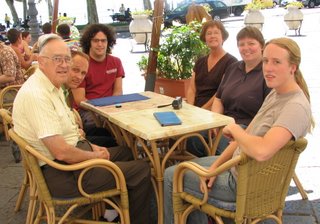
Rome
Sidewalk Restaurant
(5) I got my hair cut in Rome. When in Rome do as the Romans do – right? Actually what brought this on was a combination of my own poor planning in regard to scheduling a haircut and my impatience with the consequences. One day we sat down at a restaurant to order lunch and Mike observed that there were several male hair stylists in a nearby salon who didn’t appear to be busy. I decided to test a theory I’ve developed recently in regard to haircuts -- possibly a corollary to Murphy’s law???. My theory is that the best haircuts can never be obtained in the town in which you are living. With a little prodding, Mike agreed to go in with me and inquire about the possibilities of a haircut. The receptionist spoke English and negotiated an appointment for me 40 minutes hence with “the Professor” – a rather elderly looking man in totally unstylish mismatched clothes. I was able to figure out how to translate most of my “tried and true” instructions into sign language. His methods were totally different that anything I’ve ever experienced. But, amazingly enough, I walked out with a pretty good cut. During the haircut, he managed a couple of comments in English: “Ma’dam, you’re hair is very dry. I use a rinse?” . . . and later . . . “Ma’dam, you have too much hair.”
(6) There are lots of beggars in Rome – many of them young women with a babe in arms – and they are very aggressive. The polizia chase them off when they catch them, but they come right back again as soon as the polizia are out of sight. One day when we were eating lunch a female beggar approached our table and was not taking “no” for an answer. I told her in a loud voice to go away and motioned to that affect with my arm. She lit into me with a vengeance and did her best (in Italian) to make me feel really guilty for being so heartless to her.
So now, on to the sights themselves –
Rick Steve’s has a book out called “Mona Winks” that turned out to be invaluable on this trip (or so I think -- some members of our group were less enthusiastic). The book outlines walking tours of about 20 different locations in Europe – mostly art museums but some outdoor areas as well. It includes a couple of “walks” in Florence and a couple in Rome. The book tells you which of the exhibits in a museum are particularly worth looking at and what you need to know to appreciate what you are seeing. Lots of the places we visited had audio guides available, but we used “Mona Winks” and Rick Steve’s “Italy” instead and found that to be satisfactory. The only gripe I have is that when Rick Steve’s talks about the theology behind a particular work of art and he says things I don’t quite agree with, it is hard to tell if the problem lies with his reporting which comes out of a non-Christian worldview or with the Renaissances artists themselves. For example in the Sistine Chapel, in a scene called “The Last Judgment,” there is a self-portrait of Michaelangelo on a flayed piece of skin in the hands of St. Bartholomew. Steves thinks that this is hint that perhaps Michaelangelo had some doubts about his own personal standing before God. I’m thinking that Michaelangelo may, in fact, have been looking forward to the Last Judgment – especially the part that involves shedding that which is mortal and putting on immortality. So . . . I guess the question is “Just how theologically on target were people like Michaelangelo and Leonardo da Vince?” Guess I should read up on this a little, huh? Or maybe some of you know?
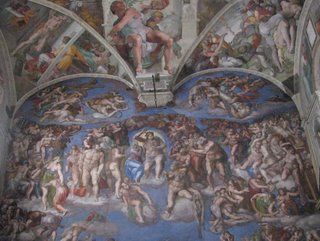
Sistine Chapel Wall "The Last Judgement"
Now, here are a couple of my favorite sites:
(1) The Sistine Chapel. To see the Sistine Chapel you have to walk through the Vatican museum, which is a very long one-way trek – no back tracking. The museum is basically a huge collection of statues and paintings from the early Christian era through the Renaissance. During the Dark Ages, the Catholic Church took on the role of preserving important works of art. It had then, and still has now, the wealth needed to store and display this art in a lavish way – hence the Vatican Museum. The Vatican Museum is interesting and “Mona Winks” was very helpful, but the highlight is definitely the Sistine Chapel at the end. Not having much info in my data bank about the Sistine Chapel, I didn’t have any preconceived ideas about its size or shape. About all I knew about it was that Michaelangelo painted the ceiling – lying on his back for many years to do it. It is in fact rectangular (not dome shaped) and pretty small – it is a chapel, not a cathedral. Located about in the center of the ceiling is the famous picture of the figures reaching out to each other with their index fingers almost touching, representing God giving to Adam the spark of life. Lots of other interesting Biblical scenes and characters as well.
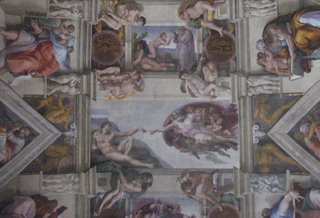
Sistine Chapel Ceiling
(2) There are several sets of catacombs in Rome. We toured one called the Catacombs of San Sebastian. It turns out that “catacomb” is a transliteration of the Greek words meaning “near the pit.” The Catacombs of San Sebastian are accessed horizontally from a depression or low spot in the ground. So the term “catacomb” was originally a description of this particular set of catacombs and then somehow came to be applied to other underground burial areas as well. During early Christian times, Romans practiced cremation. Because of their belief in a bodily resurrection, Christians wanted to bury their dead. (Not that God can’t put back together a body that has been cremated, but that attempting to preserve a dead body is sort of a way of acting out one’s belief in the future importance of the physical body.)
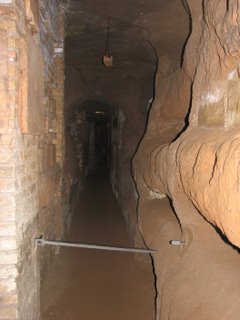
The Catacombs
Burial was not allowed within the city limits of Rome for sanitary reasons. And --- land was expensive. So Christians made the best use of any land that was donated for burial by digging several layers (or stories) of tunnels in the ground and making little alcoves or cubby holes in the walls of the tunnels in which to place the bodies. Some of the alcoves were large enough to bury an entire family. Some were only for individuals. As our guide led us through the maze of tunnels I couldn’t help thinking of that cave that Tom Sawyer and Becky Thatcher got lost in and I wondered if Injun Joe might be hiding just around the next corner. Although Christians were being persecuted during the time that the catacombs were built and used, they did not hide out in the catacombs. The Roman authorities were well aware of the existence of the catacombs so they would not have been a good place to hide. The Christians did however use the catacombs for their worship services, since they were not allowed to use other more logical places. Apparently some pagans also practiced burial and use catacombs. When Rome was Christianized in the 300 century AD, all the bodies were removed from the catacombs and reinterred in more appropriate places.
(3) As we did the sights in Rome, I kept noticing a particular kind of pine tree that we don’t have in the states. It is shaped sort of like a Tootsie Roll Pop. One day I asked “Does anyone happen to know what those pines trees are called?” My smart aleck son said “I think those are The Pines of Rome.” For all you non-musicians, “The Pines of Rome” is an orchestra suite by Respighi. It has several movements and one movement is entitled “The Pines of the Appian Way.” The Appian Way is one of those many ancient roads that led to Rome. It turns out that the entrance to the San Sebastian Catacombs is along the Appian Way. The Appian Way has been preserved and is now used as a bike / walking trail. Some of us decided that we’d like to rental bikes and go riding on the Appian Way. As you might guess we did this that same day that Dad and Curt went home early -- after the pick-pocketing and before the notorious taxi ride! Some parts of the Appian Way are paved with really large irregularly shaped stones – possibly the original ones? – which make for REALLY rough bicycle riding. But most of it is paved with smaller more regularly sized and probably newer stones. We started out about 5:45 PM. It was a gorgeous evening, the countryside was beautiful and there were some neat ruins along the way as well as some more modern estates with farm land around them. There were lots of people out walking or riding, but not too many to spoil the experience. It was peaceful and quiet and a nice change of pace from the rat race of the day. We would like to have gone a lot further than we did, but the bike rental place closed at 7:00PM.

The Appian Way
(4) The Roman Forum is a term loosely applied to a large collection of buildings – mostly ruins -- that take up the equivalent of several large city blocks adjacent to the Colosseum which is itself a ruin. There are actually other “Forums” in Rome – Trajan’s Forum, for example, which is sort of across the street from the Roman Forum. It never was clear to us whether the term “Roman Forum” properly applies to all the ruins in that area near the Colosseum or only to some small section of it. Regardless, there are an amazing number of picturesque and interesting ruins in a fairly small amount of space.
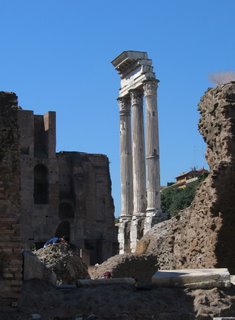
The Roman Forum

The Roman Forum

The Roman Forum
Again, “Mona Winks” was a big help in sorting out the history and significance of things, though we decided that Rick’s “Walk Through The Forum” is a little impractical during the dead of summer in that it involves spending too much time outside in the heat.
It would be better to do it in two segments with an air-conditioned museum in between
. . .
. . . or something.
Most of the ruins in the Forum became ruins, not because of time and weather, but because the pre-cut stones were carted off to other places in the centuries following the fall of
Rome to be used in other building projects.
All that is left of some buildings is an outline of foundation stones.

The Colosseum
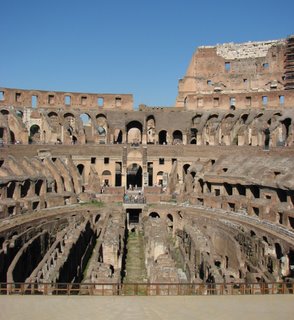
The Colosseum Interior
What was interesting about the Colosseum was the interior. I guess that I had assumed that the Colosseum was just an empty shell. It’s a lot more than that. The inside is designed a lot like our modern day stadiums with tiers of seats and a place for concessions around the outside, below the highest seats. The original floor of the arena is gone but it has been partly reconstructed to show how it would have been. Under the floor is a maze of tunnels and passageways for holding the animals and guiding them to various spots where they could then pop up through the floor and attack the human beings placed at their mercy.

"Friends, Romans and Risches,
lend me your Euro Dollars"
(5) St. Peter’s Basilica and Square, the National Museum, the Baths of Diocletian, Circus Maximus, etc. All of these were interesting but not worth adding to the length of an already too long travelogue to describe.
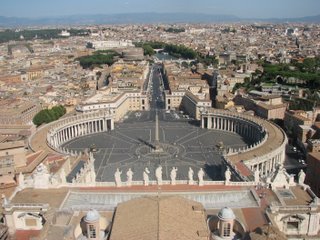
St. Peter's Square
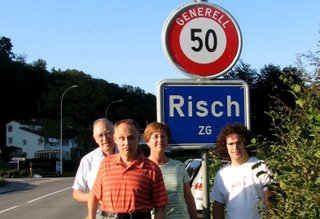
But there is one more little bit of trivia about our
Italy expedition that I can’t resist telling.
On the way to
Italy, as I was tracking our progress on the map, I just happened to notice that there is a town in
Switzerland called “Risch.”
Some of you know that my maiden name is Risch.
Some of the recipients of this travelogue bear the name Risch.
The town of “Risch” was not far from the main route to
Rome, except that we had actually gone past it at the point at which I discovered its existence.
I made a mental note to alter our route slightly on the way home and go through the town of “Risch.”
We did in fact do just that.
I don’t have any specific evidence, but it seems safe to assume that some of my not-too-far distant relatives live or lived in this town in
Switzerland.
We do know that my great-grandfather, from whom I got the name Risch, was Swiss/German.
Regardless it is a beautiful little town on the shores of the Zugersee, near
Zurich.
I would be glad to claim it as part of my heritage.
Some of you know that there is a quirky little situation that exists in the present “Risch family.” Most of the Risches pronounce their name Reesch. When my mother married my father, she got really tired of trying to convince people that there was no “e” in her name, so she started pronouncing it with a short “i” – as if it rhymed with fish. We – the “Bob Risch family” -- have pronounced it that way ever since, much to the puzzlement of the other Risches. As we hunted down the town of “Risch” and took pictures of the “city limits” sign, I was relating these facts to my children – Alan and Amy – and also to my friend Marion. Marion just happens to speak Germany fluently, having been raised by a German mother and having lived in Germany most of her life. So now I have it from an authoritative source that the correct German pronunciation for “Risch” is with a short “i.” Possibly the Swiss, who have their own version of the German language say “Reesh” – I can’t speak to that possibility (Alan, maybe you can inquire about this when you get back to Zurich?) -- but, at the very least, the short “i,” rhyming-with-fish-pronunciation is a correct one.
On to some more relevant family news –
Alan really enjoyed his month in Zurich. The manager of the Google office there is pleased about the possibility of him working there long-term. Alan has the paper work submitted for a transfer and is hoping to be back in Zurich by mid-January.
Deanna is getting settled in at Cedarville University. She and I had a good week at Harvey Cedars Bible Conference in New Jersey with our friends Ron, Mary, and Kim Tallent. Afterwards we rented a car and drove to Cedarville, Ohio. The town of Cedarville is (as we were warned) a don’t-blick-or-you-will-miss-it town and CU itself is truly surrounded by corn fields. But the campus is really nice, the freshman student / parent orientation was well planned and very helpful, the atmosphere was positive, the “rules” seem to be adequate but yet reasonable, Deanna’s roommate and parents were very nice, and so far Deanna seems to like her classes and teachers. What more could we ask for?
Mike has been told that he was not selected for either of the Family Life School Supervisory positions (Ft. Benning, GA or Ft. Hood, TX). Somehow on the heels of that announcement he has been confronted with a number of other possibilities of where he might go next, and he’s feeling a little bewildered with the whole situation. Of course, it isn’t absolutely clear how much input he actually has in the final decision. He is threatening to volunteer to go “down range” (i.e. Iraq) for a year just to end the suspense.
I’m teaching a Bible study at PWOC (Protestant Women of the Chapel) again this fall. I am doing the book of Judges – not the Precept version, but I plan to sneak in some “Preceptish” assignments. So far the response has been good. I am looking forward to getting back to a little more of a schedule. I have been gone toooooo much this past year.
Nancy
P.S. Immediately after we returned from
Rome we took off again on a 9 day excursion to
Norway.
This Friday is the beginning of a four day weekend for us military personnel.
Mike and I are headed for
Budapest, Hungary.
So I am a little behind on travelogues.
I delayed in getting this one out because I was determined to get my blog up and running so that I could post this travelogue WITH PICTURES.
Hope you enjoyed them!
For more pictures of this trip go tohttp://picasaweb.google.com/nancy.strohm?pli=1




























